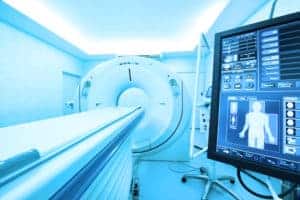
Often, these diagnostic imaging tests can sound complex or confusing, so let’s clarify what each of these tests are really all about.
Digital X-Ray
What does a digital X-ray diagnose?
Digital X-rays have been and continue to be one of the most common forms of diagnostic imaging for healthcare providers. This type of imaging technology allows for a doctor to see a digital image of your bones instantly.
Medical professionals use digital x-rays to view bones to look for a possible fracture, break, dislocation, joint damage, arthritis, and more. When a patient presents with symptoms specifically pointing to a bone or bones, the x-ray is often the first diagnostic test a doctor will use to help identify and confirm the diagnosis.
While broken bones are the most common association with an x-ray, other health concerns can also be diagnosed via x-ray, tumors, masses, and even identifying serious concerns in the lungs like tuberculosis or pneumonia.
What is a digital X-ray like?
As a patient, an X-ray is a bit like having your photo taken by a very large camera. An X-ray can be taken on a specific part of the body or of the whole body, and the patient can be sitting, standing, or lying down.
It is a quick process, where the ‘camera’ sends a small burst of radiation through the area of the body being imaged. While radiation is involved in x-rays, the exposure is usually minimal and you can always speak to your doctor about this for more information.
CT Scan: Computerized Tomography Scan
What does a CT Scan diagnose?
A CT scan is like a 3D X-ray, a combination of a few x-ray images taken from multiple angles at once to show not only bones but also other organs and tissues. A CT scan is helpful for your doctor to see a more detailed, comprehensive image of the area of concern.
When are CT scans used?
Like X-rays, CT scans can also be used to identify, diagnose, and even monitor other health concerns like cancer, blood clots, tumors, infections, and more. Doctors may use a CT scan to view an injury from multiple angles to quickly identify the source of pain or concern.
While X-ray is the most common diagnostic imaging test for chiropractors, they may also use CT scans to get a more comprehensive image and provide better quality treatment.
MRI: Magnetic Resonance Imaging
What does an MRI diagnose?
An MRI is used when an injury or health concern has been identified and the doctor wants to view the severity of tissue damage to help with further diagnosis and treatment. Unlike x-rays and CT scans, MRIs do not use radiation, but instead use a combination of radio waves and magnets to create an image specifically of the soft tissues of your body, which are less visible on an x-ray.
MRIs can be used in diagnosis and for monitoring the process of healing within the soft tissue. MRIs can detect many health concerns, such as cancer, heart disease, joint damage, bone infections, damage to blood vessels in the spinal cord or brain, and more.
How are MRIs used by various specialists?
An MRI is a versatile diagnostic imaging tool and all of our specialists at AICA Orthopedics use the MRI in various ways to help inform our individualized treatment plans:
• Injury doctors may use an MRI to detect any injuries you may have sustained during a car accident, even if you have not experienced any serious symptoms yet.
• Orthopedic doctors use MRIs to view the soft tissues in the musculature surrounding an injury or area of pain to identify tears and sprains.
• Neurologists use MRIs for a thorough image of the brain to help see any fluids or bleeding on the brain.
• Chiropractors may also utilize an MRI to provide additional information about the soft tissues surrounding a spinal injury or misalignment.
At AICA Orthopedics, we have an Imaging Center in Atlanta with state-of-the-art diagnostic imaging technology so our team of orthopedic doctors and medical professionals can best diagnose and treat our patients. These advanced diagnostic tests are all available to our patients in one central location in Atlanta so our patients can receive the best care all in one place. Contact us today to learn more about what diagnostic imaging you might require.
